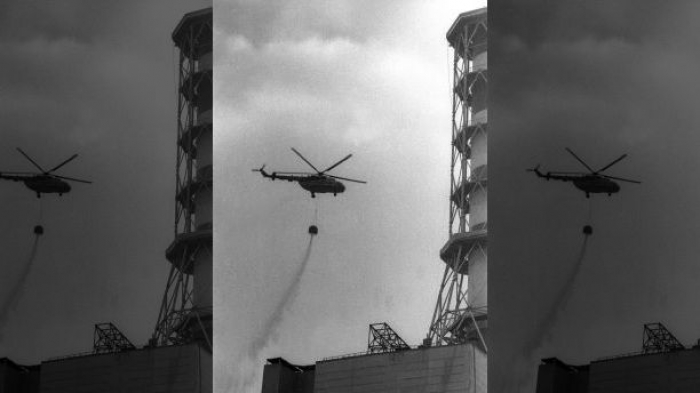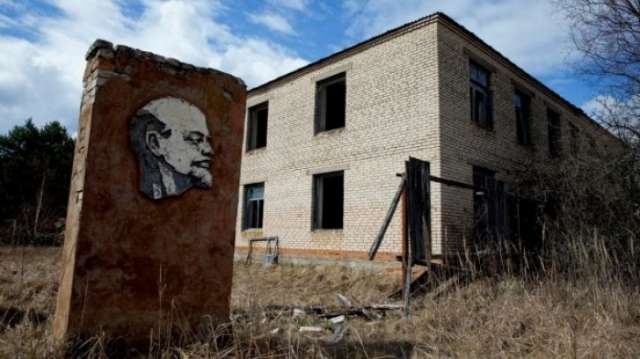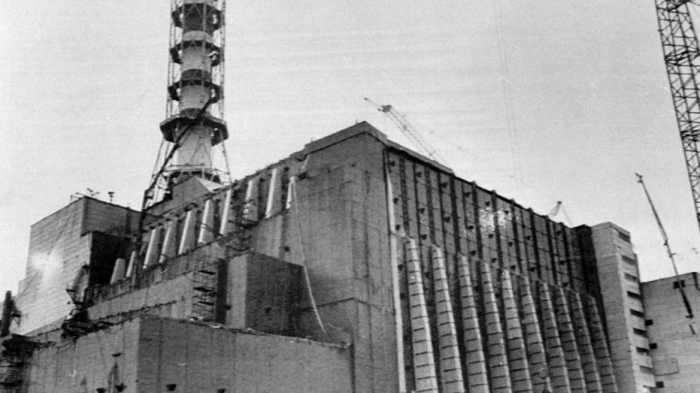“We realized that we, based on real measurements and observations, could explain details in the Chernobyl accident scenario and the nature of the two major explosions that occurred during a few seconds that unfortunate night more than 31 years ago,” explained the report’s lead author Lars-Erik De Geer, in an email to Fox News.
The 1986 explosion at the Chernobyl nuclear plant in Ukraine sparked a widespread environmental disaster. Thirty workers died either from the explosion at the number four reactor or from acute radiation sickness within several months. The accident exposed millions in the region to dangerous levels of radiation and forced a wide-scale, permanent evacuation of hundreds of towns and villages in Ukraine and Belarus.
 A helicopter dropping concrete onto the fourth reactor of the Chernobyl nuclear power after its explosion is seen in this 1986 file picture. (Reuters)
A helicopter dropping concrete onto the fourth reactor of the Chernobyl nuclear power after its explosion is seen in this 1986 file picture. (Reuters)A cloud of radioactive particles from the disaster reached other parts of parts of Europe, such as Sweden.
The report cites xenon isotopes detected by the V.G. Khlopin Radium Institute in Leningrad four days after the accident. Leningrad, now known as Saint Petersburg, is about 599 miles north of Chernobyl. Xenon isotopes were also reported in Cherepovets, about 622 miles north of Chernobyl.
The result of recent nuclear fission, the isotopes were likely caused by a recent nuclear explosion, according to the experts. This is in contrast to the main Chernobyl debris that contained equilibrium xenon isotopes from the reactor’s rupture and drifted toward Scandinavia.
This new theory presented by experts from the Swedish Defence Research Agency, the Swedish Meteorological and Hydrological Institute and Stockholm University, could offer fresh insight into the disaster. The new analysis could help prevent similar incidents from occurring, experts say.

A panel with a portrait of Soviet state founder Vladimir Lenin and an abandoned building are seen at the 30 km (19 miles) exclusion zone around the Chernobyl nuclear reactor in the abandoned village of Orevichi, Belarus, March 12, 2016. (REUTERS/Vasily Fedosenko)
The destroyed reactor tank suggests that the first explosion caused temperatures high enough to melt a 6.6-foot bottom plate in part of the core, the researchers said, noting that this damage is consistent with a nuclear explosion. In the rest of the core, the bottom plate was relatively intact, but had dropped by nearly 13 feet. This, they say, is consistent with a steam explosion, noting that the temperature would not be sufficient to melt the plate, but could generate enough pressure to force it down.
Additionally, seismic measurements and eyewitness reports of a blue flash above the reactor a few seconds after the first explosion could also support the new theory of a nuclear explosion followed by a steam explosion.
De Geer told Fox News that the Chernobyl disaster could only happen in Soviet-era reactors built using a design known as Reaktor Bolshoy Moshchnosti Kanalnyy (RBMK), or ‘High Power Channel-Type Reactor.’ There are 11 RBMK Reactors operating in Russia, according to The World Nuclear Association.
“Our new theory deepens the understanding of the severe effects that can be the result of some original design faults in such reactors,” he said. “Much has been corrected in remaining RBMK reactors, but a better understanding of what really happened in 1986 must of course be of great value for overseeing and possibly improving the design also in the future.”
The disaster shone a spotlight on lax safety standards and government secrecy in the former Soviet Union. The explosion on April 26, 1986, was not reported by Soviet authorities for two days, and then only after winds had carried the fallout across Europe and Swedish experts had gone public with their concerns.
The final death toll from Chernobyl is subject to speculation, due to the long-term effects of radiation. Estimates range from 9,000 by the World Health Organization to one of a possible 90,000 by the environmental group Greenpeace.
The terrible environmental fallout of Chernobyl is still being felt. A wild boar with more than 10-times the safe limit of radiation, for example, was recently killed by hunters hundreds of miles away in Sweden.
More about: #Chernobyldisaster
















































